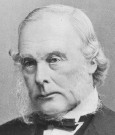Through the Lens of Oncology History
A Century of Progress
The text and photographs on this page are excerpted from a four-volume series of books titled Oncology Tumors & Treatment: A Photographic History, by Stanley B. Burns, MD, FACS. The photos below are from the volume titled “The Anesthesia Era: 1845–1875.” To view additional photos from this series of books, visit burnsarchive.com.
The Anesthesia Era 1845–1875
Woodburytype, Philadelphia, 1869
Infection was the roadblock to the advancement of surgery. The lengthy and complicated operations that anesthesia permitted often resulted in high morbidity and mortality. Every operation was expected to cause an infection. The most common hospital infections were erysipelas, hospital gangrene, and pyemia (septicemia), with mortality rates of over 90%. If the patient contracted one of these infections, death was the usual outcome. One Philadelphia surgeon, however, bucked the odds. His patients didn’t get infections, and they healed their wounds by primary intention.
During the Civil War, the research conclusions of Louis Pasteur, stating that putrefaction and bacteria caused fermentation, were published. English surgeon Joseph Lister, MD (1827–1912), implemented Pasteur’s idea into a landmark medical proposal. Since foreign matter, bacteria, dirt, etc. were the culprits in wound infection, he recognized that by keeping a wound clean, it would heal without infection. Dr. Lister’s antiseptic wound treatment and surgical antiseptic procedures were the second greatest medical innovation of the 19th century. With the knowledge of the fatality rate from secondary infections during the Civil War and in light of both Pasteur’s and Lister’s work, physicians were certainly not responsive to the therapy suggestions of Philadelphia surgeon Addinell Hewson, MD (1828–1889). Dr. Hewson proposed an innovative wound treatment using earth as the dressing. A fascinating aspect of medical history is that occasionally great ideas and advances lay hidden in old books and journals; however, open minds and new technologies are sometimes necessary to understand and implement the discoveries of the past.
In 1872, Dr. Hewson published Earth as a Topical Application in Surgery. He described his treatment of wounds and operative cases using an application of earth as a dressing with its accompanying acceleration of the healing process. He detailed 93 cases, including ulcers, burns, gunshot wounds, and operations such as this mastectomy. The cases were all treated during a 6-month period in 1869 at the Pennsylvania Hospital.
All wounds were dressed with his special dirt and all healed quickly, most within 15 days. Dr. Hewson attributed this healing to the action of the ozone, deoxygenating, and released ammonia. It was more likely that the infection was inhibited by the presence of a naturally occurring antibacterial agent in the soil such as bacitracin.
Unfortunately for Dr. Hewson, his work appeared at the same time that Dr. Lister’s antiseptic surgical technique was being promoted. Packing wounds with dirt made no sense to a profession recently advised of the necessity for cleanliness. Had Dr. Hewson’s findings been evaluated more seriously, the age of antibiotics might have dawned a half-century sooner.
This photograph is one of two he published showing his success with mastectomy. “Hannah C. admitted to the hospital on the 12th of February for a scirrhous tumor of the right mamma.” The 41-year-old widow with three children presented with the cachexia of cancer. “Operation of excision of the whole gland was performed before the class of the hospital on the 17th of February over 40 square inches of wound surface (had) to be healed. Dry earth was spread over the breast, and retained by some pieces of white unglazed paper and a roller around the chest.” The earth dressing was renewed daily and on the 24th the gauze was removed, “and found union firm and complete.” On the 27th of February, this photograph was taken. “In January, 1871 nearly 3 years after the operation, there was no return of disease.” ■


